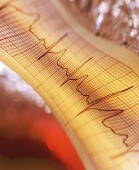- Skip Storing This Everyday Product in the Fridge Door
- Green Tea + B3 Pairing May Boost Brain Health
- Navigating Your Midlife Crisis: Embracing New Possibilities
- City Raccoons Showing Signs of Domestication
- Mapping the Exposome: Science Broadens Focus to Environmental Disease Triggers
- One Week Less on Social Media Linked to Better Mental Health
- Your Brain Changes in Stages as You Age, Study Finds
- Some Suicide Victims Show No Typical Warning Signs, Study Finds
- ByHeart Formula Faces Lawsuits After Babies Sickened With Botulism
- Switch to Vegan Diet Could Cut Your Greenhouse Gas Emissions in Half
Too Few Older Heart Attack Patients Get Implanted Defibrillators, Study Finds


Fewer than one in 10 older heart attack survivors gets a potentially lifesaving implantable defibrillator, a new study finds.
This small, battery-powered device sits under the skin in the chest. If the heart starts beating abnormally or stops altogether, the defibrillator shocks the heart to restore a normal rhythm.
Heart doctors say many heart attack survivors — but not all — would benefit from such a device.
“We do not think that 100 percent of patients with weak hearts after heart attacks should be getting implanted defibrillators,” said study lead researcher Dr. Sean Pokorney, a cardiology fellow at Duke University School of Medicine, in Durham, N.C.
However, he added, “sometimes heart function recovers, but this is uncommon and does not fully explain the very low implantation rates observed in our study.”
Even among those who would benefit most — patients with large amounts of heart damage and very weak hearts — the rate remained low, said Pokorney, who has received support in the past from Boston Scientific Inc., a maker of implantable defibrillators.
For the study, Pokorney’s team collected data on more than 10,300 heart attack patients, average age 78, with reduced heart function who were listed in a national cardiovascular data registry.
Those who got implantable defibrillators had a one-third lower risk of death after two years than those who didn’t get one, the researchers found.
Clinical trials for implanted defibrillators have included patients with an average age in the 60s, but the benefit of these devices has not been well-established in adults older than this, Pokorney noted.
“Our results are encouraging, since defibrillators in older patients were associated with the same amount of benefit as in younger patients in the clinical trials,” Pokorney said.
One barrier is the cost of the device, which can run from $25,000 to $30,000, according to a recent study. However, for Americans aged 65 and older the cost is covered by Medicare, Pokorney said.
Perhaps the biggest contributor to the low rate of defibrillator use is a lack of communication and coordination after hospital discharge, Pokorney said.
A 40-day waiting period is required between having a heart attack and eligibility for an implanted defibrillator. This is a critical time when care is transferred from the hospital to the outpatient clinic, he said.
“Close outpatient follow-up is critical for patients with weak hearts after heart attacks, and the health care system needs to continue to focus on improving communication between care providers in the hospital and in the outpatient clinic,” he said.
The new study was published in the June 23/30 issue of the Journal of the American Medical Association.
More than 300,000 people in the United States die from sudden cardiac arrest, a sudden loss of heart function, each year. Previous studies have found that as many as 80 percent of these patients were eligible for but did not have a defibrillator, the researchers reported.
Dr. Robert Hauser, a senior consulting cardiologist at the Minneapolis Heart Institute at Abbott Northwestern Hospital and author of an accompanying journal editorial, agreed that many older patients who could benefit from an implanted defibrillator aren’t getting one.
“Too few eligible elderly patients are receiving primary prevention implanted defibrillators to prevent sudden death after a heart attack,” he said. “We need strategies to identify elderly patients at risk so they may decide whether or not to undergo a defibrillator implantation.”
More information
For more on implantable defibrillators, visit the U.S. National Heart, Lung, and Blood Institute.
Source: HealthDay
Copyright © 2025 HealthDay. All rights reserved.










